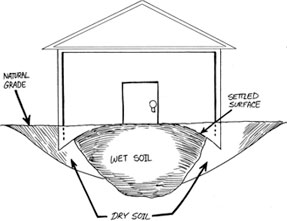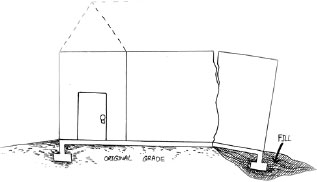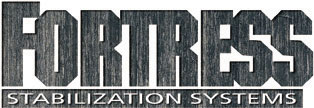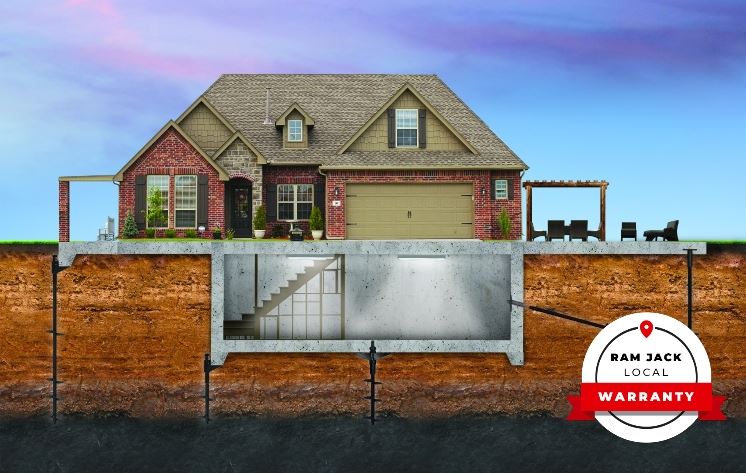Why is My Home’s Foundation Beginning to Settle?
Have you started to notice cracks appearing in your brick, stucco, or sheetrock? Does your house seem to be sinking? Don't wait for seasonal or climatic changes to further damage your house. Call or contact Ram Jack and let us evaluate your home. Ram Jack is the full-service foundation repair company that pioneered the industry with professionally evaluated foundation repair methods.
More information about the signs and symptoms of foundation issues >
UNDERSTAND THE CAUSES OF FOUNDATION CRACKING AND SHIFTING
 Water is the primary enemy in expansive soils problems. There is either
too much water, causing the soil to swell, or not enough, causing the
soil to shrink. Moisture beneath the center of your foundation remains
consistent unless aggravated by the introduction of excess moisture, such
as plumbing leaks or sub-surface water movement. As evaporation and transpiration
cause the soils to dry and shrink around the perimeter of your foundation,
the structure begins to move. Uneven moisture causes uneven movement,
which can lead to both structural and cosmetic damage to your home.
Water is the primary enemy in expansive soils problems. There is either
too much water, causing the soil to swell, or not enough, causing the
soil to shrink. Moisture beneath the center of your foundation remains
consistent unless aggravated by the introduction of excess moisture, such
as plumbing leaks or sub-surface water movement. As evaporation and transpiration
cause the soils to dry and shrink around the perimeter of your foundation,
the structure begins to move. Uneven moisture causes uneven movement,
which can lead to both structural and cosmetic damage to your home.
If all soils beneath a foundation swell uniformly or shrink uniformly, it is unlikely to cause a problem. But when only part of the foundation heaves or settles, differential movement causes cracked brick and other damages.
Most differential movement is caused by differences in soil moisture. After construction, soil beneath part of the foundation becomes wetter or drier than the rest of the soil.
WHY HOUSES SETTLE AND CRACK DUE TO WATER FLUCTUATIONS
1. There is a gain in soil moisture: This is the most serious threat since the swelling potential of expansive soils is much greater than the shrinkage potential. Moisture gain can come from plumbing leaks, subsurface water like wet weather or a high water table, or surface water, including improper drainage of landscape water or excessive rainwater.
Poor drainage is a major contributor to soil moisture gains. Roof runoff should be directed away from the house through the use of gutters, and gutter downspouts should not be permitted to discharge the water next to the foundation. Surface drainage next to the foundation should slope away from the house approximately ¼ " per foot.
2. There is a loss of soil moisture: The soil may be at or near its optimum moisture content when the foundation is built, but it may lose enough moisture during a drought to cause the foundation to settle. Settlement is usually greatest near the perimeter of the foundation where the soil dries most quickly.
3. Extremely low or high soil moisture exists during construction: If the soil content is very low when a slab-on-grade foundation is poured, soil to the slab edges regains moisture first because it is directly exposed to rainwater or irrigation water. If the soil moisture is extremely high during construction, the slab will hold in the moisture except at the perimeter, where it is exposed to more wind and heat. In these cases, the slab edge loses moisture at a different rate than the soils under the house and the house will settle.
 4. There is poor pre-construction compaction of the building pad: Slab-on-grade foundations depend on the uppermost soil layers to provide
bearing capacity to support the structure and keep the foundation stable.
If the bearing soil was not compacted properly during grading, the foundation
is subject to settlement as the supporting soil consolidates.
4. There is poor pre-construction compaction of the building pad: Slab-on-grade foundations depend on the uppermost soil layers to provide
bearing capacity to support the structure and keep the foundation stable.
If the bearing soil was not compacted properly during grading, the foundation
is subject to settlement as the supporting soil consolidates.
When a house or building is supported by various soils in various conditions, the structure may settle differentially. As an example, if one half of the foundation sits upon expansive clay and the other half bears on select fill and/or rock, the amount of seasonal movement will vary from one half to the other half. If the foundation system is not properly designed, the differential movement may cause damage to the foundation and structure.
DIFFERENTIAL SETTLEMENT CAUSES BUILDINGS TO CRACK
A few things need to be understood about settlement. First, all houses settle. The amount may be so small as to be undetectable or may be so uniform as to leave no signs, but it unquestionably happens. Second, because of the natural and construction-related variations in soil properties, not every point on a foundation settles the same amount. To avoid continued cracking door frames and cracked brick, you must sustain differential settlement, the difference in settlement between various points on the foundation. The distinction between total and differential settlement is important.
The Palace of Fine Arts in Mexico City, for instance, has settled several feet without significant distress to the structure and remains in service because the settlement has been uniform.
The Leaning Tower of Pisa, on the other hand, is useless for anything but the Kodak moments of tourists.
WHAT IS UNDERPINNING?
Foundation support can only be achieved through underpinning. Underpinning is the process of modifying an existing foundation system by extending it to, or into, subsurface strata that is deeper and more stable than the near surface soil that supports the existing foundation system. Underpinning extends the foundation support to depths that provide greater bearing capacity and/or are less affected by climate and soil conditions.
If underpinning is properly designed and installed, it will provide the basis for lifting the house or building to a more acceptable elevation and will provide vertical support to prevent the underpinned areas from future settling.
REPAIR BOWED OR CRACKED BASEMENT WALLS
 Ram Jack is a certified installer of Fortress Support Systems. These carbon
fiber/Kevlar® grid strap reinforcement systems are designed to sustain
and repair concrete, foundation, and other structures that have fractured
or bowed due to soil pressure, water damage or other causes. Carbon fiber/Kevlar
grid straps are proven to be the best solution on the market today, providing
innovative solutions for concrete reinforcement.
Ram Jack is a certified installer of Fortress Support Systems. These carbon
fiber/Kevlar® grid strap reinforcement systems are designed to sustain
and repair concrete, foundation, and other structures that have fractured
or bowed due to soil pressure, water damage or other causes. Carbon fiber/Kevlar
grid straps are proven to be the best solution on the market today, providing
innovative solutions for concrete reinforcement.
Ram Jack will professionally evaluate your home to determine what settlement issues you may have. Our technicians are trained and certified through the Ram Jack training program. We will investigate your entire house or structure, not just the areas of visible settlement and cracking. Once the settlement has been accurately diagnosed, we will design a service plan with a diagram of your home, pinpointing the locations we recommend installing piers to sustain the foundation. We will give the service plan and diagrams to you at the end of the evaluation.
To schedule a no-charge professional evaluation of your home's foundation, contact Ram Jack South Carolina at (803) 398-5208.




